
Bovines comprise a diverse group of 10 genera of medium to large-sized ungulates, including cattle, bison, African buffalo, water buffalos, and the four-horned and spiral-horned antelopes. The evolutionary relationship between the members of the group is still debated, and their classification into loose tribes rather than formal subgroups reflects this uncertainty. General characteristics include cloven hooves and usually at least one of the sexes of a species having true horns. The largest extant bovine is the gaur.

Gavialidae is a family of large semiaquatic crocodilians with elongated, narrow snouts. Gavialidae consists of two living species, the gharial and the false gharial, both occurring in Asia. Many extinct members are known from a broader range, including the recently extinct Hanyusuchus. Gavialids are generally regarded as lacking the jaw strength to capture the large mammalian prey favoured by crocodiles and alligators of similar size so their thin snout is best used to catch fish, however the false gharial has been found to have a generalist diet with mature adults preying upon larger vertebrates, such as ungulates.

Desmodus is a genus of bats which—along with the genera Diaemus and Diphylla—are allied as the subfamily Desmodontinae, the carnivorous, blood-consuming vampire bats of the New World leaf-nosed bat family Phyllostomidae.

The subfamily Alcelaphinae, of the family Bovidae, contains the wildebeest, tsessebe, topi, hartebeest, blesbok and bontebok, and several other related species. Depending on the classification, there are 6–10 species placed in four genera, although Beatragus is sometimes considered a subgenus of Damaliscus, while Sigmoceros is sometimes considered for the Lichtenstein's hartebeest.
Nesoryzomys darwini, also known as Darwin's nesoryzomys or Darwin's Galápagos mouse, is an extinct species of rodent in the genus Nesoryzomys.

Batomys is a genus of rodent endemic to the Philippines. It has six extant described species.

Pneumatoarthrus is an extinct genus of sea turtle known from the Late Cretaceous Mount Laurel Formation of Monmouth County, New Jersey. Only a single species, P. peloreus, is known.
The Viti Levu snipe is an extinct species of austral snipe endemic to Fiji. A species of the mostly New Zealand genus Coenocorypha, it became extinct after the arrival of humans in Fiji.

Lepicerus is a genus of myxophagan beetles containing three described species in the family Lepiceridae; it is the only extant genus in the family, with another genus, Lepiceratus only known from fossils. Extant species occur in the Neotropics, from Mexico south to Venezuela and Ecuador. Fossils referrable to the genus are known from the early Late Cretaceous of Southeast Asia.
Bashkirosaurus is an extinct genus of archegosauroidean temnospondyl within the family Archegosauridae. Locality: Belebei locality, Belebeiskii District, Bashkortostan (Bashkiry) Province, Western Cisuraly, European Russia.
Procochleosaurus is an extinct genus of cochleosaurid temnospondyl. Known from the Jarrow coal mines of Ireland, this genus is the oldest known member of the family Cochleosauridae. It was quite similar to Cochleosaurus, an early temnospondyl from the Czech Republic.
Chelydrops is an extinct genus of Chelydridae from Miocene of North America. Only one species is described, Chelydrops stricta.
Coburgosuchus is an extinct genus of mystriosuchin phytosaur. The genus was named for Coburg, Germany, the type locality where specimens have been found dating back to the Late Triassic. It has at times been considered a nomen dubium due to the fragmentary nature of the material associated with the genus, and it may prove to be synonymous with other phytosaurs such as Nicrosaurus or Phytosaurus.

Bolotridon is an extinct genus of epicynodontian cynodont. It was renamed from its original genus designation of Tribolodon, which was already occupied by a genus of cyprinid fish named in 1883 by Sauvage. The name Bolotridon was coined by Brian W. Coad in a 1977 publication as an anagram of Tribolodon.

Equini is the only living tribe of the subfamily Equinae, which has lived worldwide since the Hemingfordian stage of the Middle Miocene. It is considered to be a monophyletic clade.

Smicripidae is a family of beetles, in the superfamily Cucujoidea. The common name for this family is palmetto beetles. The family only has one extant genus, Smicrips, with six extant species native to tropical and subtropical regions of the Americas and extinct species from the Eocene of Europe and one extinct genus, Mesosmicrips, known from the mid Cretaceous aged Burmese amber. Smicrips larvae are usually found amongst decaying vegetation, while adults are typically found on inflorescences, especially those of Arecaceae (palms), although associations with flowers of Fabaceae (legumes), Passifloraceae, Bombacaceae and Cactaceae (cactus) have also been recorded. Their diet is unknown.

Bashuchelys is an extinct genus of bashuchelyid Middle Jurassic turtle from the Sichuan Basin in the People's Republic of China. As of 2011, it is the only known genus of the family Bashuchelyidae.

Neomonachus is a genus of earless seals, within the family Phocidae. It contains two species: the endangered Hawaiian monk seal, and the extinct Caribbean monk seal. Prior to 2014, all three species of monk seals were placed in the genus Monachus, but that was found to be paraphyletic.

Soriculus is a genus of shrew native to Asia. Along with several fossil species, the only extant member of the genus is the Himalayan shrew, as other extant species have now been transferred to other genera.
Taphrosphys is an extinct genus of bothremydid pleurodiran turtle that was discovered Angola, Morocco and the United States. The genus consists of type species Platemys sulcatus, T. ippolitoi, T. congolensis, and the dubious T. dares.












